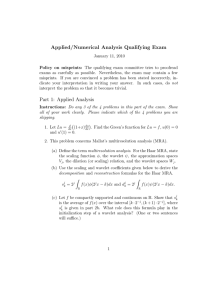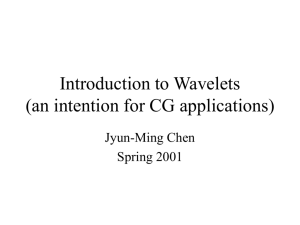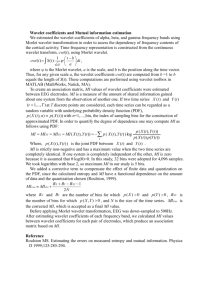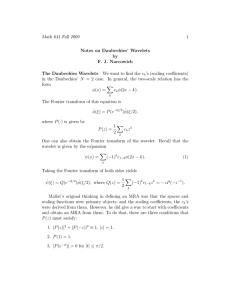INFINITE MATRICES, WAVELET COEFFICIENTS AND FRAMES
advertisement
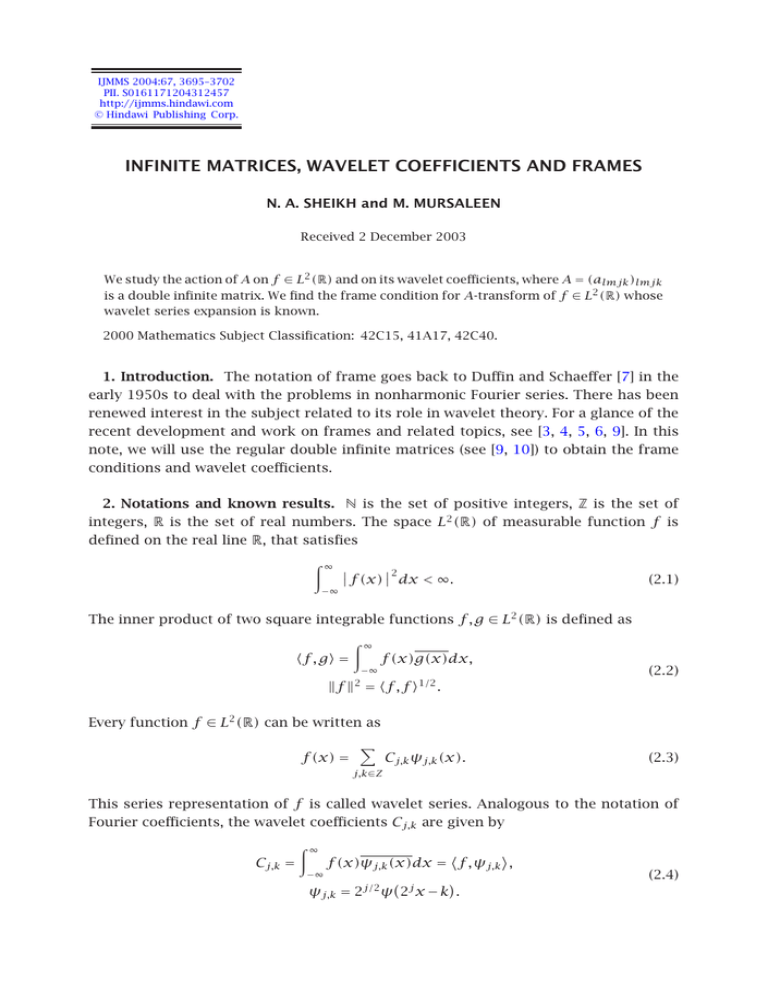
IJMMS 2004:67, 3695–3702
PII. S0161171204312457
http://ijmms.hindawi.com
© Hindawi Publishing Corp.
INFINITE MATRICES, WAVELET COEFFICIENTS AND FRAMES
N. A. SHEIKH and M. MURSALEEN
Received 2 December 2003
We study the action of A on f ∈ L2 (R) and on its wavelet coefficients, where A = (almjk )lmjk
is a double infinite matrix. We find the frame condition for A-transform of f ∈ L2 (R) whose
wavelet series expansion is known.
2000 Mathematics Subject Classification: 42C15, 41A17, 42C40.
1. Introduction. The notation of frame goes back to Duffin and Schaeffer [7] in the
early 1950s to deal with the problems in nonharmonic Fourier series. There has been
renewed interest in the subject related to its role in wavelet theory. For a glance of the
recent development and work on frames and related topics, see [3, 4, 5, 6, 9]. In this
note, we will use the regular double infinite matrices (see [9, 10]) to obtain the frame
conditions and wavelet coefficients.
2. Notations and known results. N is the set of positive integers, Z is the set of
integers, R is the set of real numbers. The space L2 (R) of measurable function f is
defined on the real line R, that satisfies
∞
−∞
f (x)2 dx < ∞.
(2.1)
The inner product of two square integrable functions f , g ∈ L2 (R) is defined as
f , g =
∞
−∞
f (x)g(x)dx,
(2.2)
f 2 = f , f 1/2 .
Every function f ∈ L2 (R) can be written as
f (x) =
Cj,k ψj,k (x).
(2.3)
j,k∈Z
This series representation of f is called wavelet series. Analogous to the notation of
Fourier coefficients, the wavelet coefficients Cj,k are given by
Cj,k =
∞
f (x)ψj,k (x)dx = f , ψj,k ,
−∞
ψj,k = 2j/2 ψ 2j x − k .
(2.4)
3696
N. A. SHEIKH AND M. MURSALEEN
Now, if we define an integral transform
Wψ f (b, a) = |a|−1/2
∞
−∞
f (x)ψ
x −b
dx,
a
f ∈ L2 (R),
(2.5)
then the wavelet coefficients become
Cj,k = Wψ f
k 1
.
,
2j 2j
(2.6)
A sequence {xn } in a Hilbert space H is a frame if there exist constants c1 and c2 ,
0 < c1 ≤ c2 < ∞, such that
c1 f 2 ≤
f , xn 2 ≤ c2 f 2 ,
(2.7)
n∈Z
for all f ∈ H. The supremum of all such numbers c1 and infimum of all such numbers c2 are called the frame bounds of the frame. The frame is called tight frame when
c1 = c2 and is called normalized tight frame when c1 = c2 = 1. Any orthonormal basis in
a Hilbert space H is a normalized tight frame. The connection between frames and numerically stable reconstruction from discretized wavelet was pointed out by Grossmann
et al. [8]. In 1985, they defined that a wavelet function ψ ∈ L2 (R), constitutes a frame
with frame bounds c1 and c2 , if any f ∈ L2 (R) such that
c1 f 2 ≤
f , ψj,k 2 ≤ c2 f 2 .
(2.8)
j,k∈z
Again, it is said to be tight if c1 = c2 and is said to be exact if it ceases to be frame by
removing any of its elements. There are many examples proposed by Daubechies et al.
[6]. For further details, one can refer to [1, 5, 6]. Chui and Shi [2] proved that {ψj,k }
is a frame for L2 (R) with bounds c1 and c2 , if for some a > 1 and b > 0, the Fourier
transform ψ̂ satisfies
c1 ≤
1 ψ̂ aj w 2 ≤ c2 a.e.,
b j∈Z
(2.9)
for some constants c1 and c2 . By integrating each term in
2
1 ψ̂ aj w c2
c1
≤
≤
|w|
b j∈Z
|w|
|w|
(2.10)
j 2
ψ̂ a w 1 dw ≤ 2c2 log a,
b j∈Z 1≤|w|≤a
|w|
(2.11)
over 1 ≤ |w| ≤ a, we have
2c1 log a ≤
which immediately yields
c1 ≤
1
2b log a
∞ ψ̂ aj w 2
dw ≤ c2 .
|w|
−∞
(2.12)
WAVELET COEFFICIENTS AND FRAMES
3697
The above condition known as compactibility condition was also observed by
Daubechies [4] by using techniques from trace class operators. The above constants
were given by frame bounds, see [2].
Let A = (amnjk ) be a double infinite matrix of real numbers. Then, A-transform of a
double sequence x = (xjk ) is
∞
∞ amnjk xjk ,
(2.13)
j=0 k=0
which is called A-means or A-transform of the sequence x = (xij ). This definition is
due to Móricz and Rhoades [9].
A double matrix A = (amnjk ) is said to be regular (see [10]) if the following conditions
hold:
∞
(i) limm,n→∞ j,k=0 amnjk = 1,
∞
(ii) limm,n→∞ j=0 |amnjk | = 0, (k = 0, 1, 2, . . .),
∞
(iii) limm,n→∞ k=0 |amnjk | = 0, (j = 0, 1, 2, . . .),
∞
(iv) A = supm,n>0 j,k=0 |am,n | < ∞.
Either of conditions (ii) and (iii) implies that
lim amnjk = 0.
m,n→∞
(2.14)
In this note, we establish the frame condition by using A-transform of nonnegative
regular matrix, also we find action of the matrix A on wavelet coefficients.
3. Main results. In this section, we prove the following theorems.
Theorem 3.1. Let A = (ailjk ) be a double nonnegative regular matrix. If
f (x) =
Cj,k ψj,k (x)
(3.1)
j,k∈Z
is a wavelet expansion of f ∈ L2 (R) with wavelet coefficients
∞
f (x)ψj,k (x)dx = f , ψj,k ,
Cj,k =
−∞
(3.2)
then the frame condition for A-transform of f ∈ L2 (R) is
c1 f 2 ≤
Af , ψi,l 2 ≤ c2 f 2 ,
(3.3)
i,l∈Z
where Af is the A-transform of f and 0 < c1 ≤ c2 < ∞.
Theorem 3.2. If Cj,k are the wavelet coefficients of f ∈ L2 (R), that is, Cj,k = f , ψj,k ,
then the dl,m are the wavelet coefficients of Af , where {dl,m } is defined as the Atransform of {Cj,k } by
dl,m =
∞
j,k=−∞
almjk Cjk .
(3.4)
3698
N. A. SHEIKH AND M. MURSALEEN
Theorem 3.3. Let A = (almjk ) be a double nonnegative matrix whose elements are
ψj,k , ψl,m . Then, {ψj,k } constitutes a frame of L2 (R) if and only if {ψl,m } constitutes
a frame of L2 (R), where Cj,k = f , ψj,k and dl,m = f , ψl,m .
Proof of Theorem 3.1. We can write
f (x) =
f , ψj,k ψj,k .
(3.5)
j,k∈Z
If we take A-transform of f , we get
Af (x) =
Af , ψi,l ψi,l ,
(3.6)
i,l∈Z
and therefore
∞ Af , ψi,l 2 ≤
Af (x)2 ψi,l (x)2 dx
i,l∈Z
i,l∈Z
−∞
≤ A2 f 22
ψi,l 2 .
(3.7)
2
i,l∈Z
Since A is regular matrix and ψi,l 2 = 1, therefore
Af , ψi,l 2 ≤ c2 f 2 ,
2
(3.8)
i,l∈Z
where c2 is positive constant.
Now, for any arbitrarily f ∈ L2 (R), define
f˜ =
−1/2
Af , ψi,l 2
f.
(3.9)
i,l∈Z
Clearly,
−1/2
2
˜
Af , ψi,l =
Af , ψi,l ,
Af , ψi,l |
(3.10)
i,l∈Z
then
Af , ψi,l 2 ≤ 1.
i,l∈Z
(3.11)
WAVELET COEFFICIENTS AND FRAMES
3699
Hence, if there exists α a positive constant, then
Af˜2 ≤ α,
2
−1
2
Af , ψi,l Af 2 ≤ α.
(3.12)
2
i,l∈z
Since A is regular, we have
−1
Af , ψi,l 2 f 2 ≤ α1 = α
,
2
A2
i,l∈z
(3.13)
where α1 is another positive constant. Therefore,
c1 f 22 ≤
Af , ψi,l 2 ,
(3.14)
i,l∈z
where c1 = α > 0.
Combining (3.8) and (3.14), we have
c1 f 22 ≤
Af , ψi,l 2 ≤ c2 f 2 .
2
(3.15)
i,l∈z
This completes the proof.
Proof of Theorem 3.2. We can write
∞
Af (x)ψl,m (x)dx
Af , ψj,k =
−∞
=
∞
(3.16)
∞
−∞
almjk cj,k ψj,k (x)ψl,m (x)dx.
j,k=−∞
Now,
∞
∞
Af , ψl,m ψl,m =
l,m=−∞
l,m=−∞
∞
=
∞
−∞
∞
almjk cj,k ψj,k (x)ψl,m (x)ψl,m (x)dx
j,k−∞
∞
dl,m ψl,m
l,m=−∞
∞
=
−∞
ψl,m (x)2
2
(3.17)
dl,m ψl,m .
l,m=−∞
Therefore,
∞
l,m=−∞
dl,m ψl,m =
∞
Af , ψl,m ψl,m .
l,m=−∞
This implies that dl,m are wavelet coefficients of Af .
(3.18)
3700
N. A. SHEIKH AND M. MURSALEEN
Thus,
dl,m = f , ψl,m .
(3.19)
This completes the proof.
Proof of Theorem 3.3. We observe that
almjk Cj,k = ψj,k , ψl,m f , ψj,k
∞
∞
ψj,k (x)ψl,m (x)dx
f (x)ψj,k (x)dx
=
−∞
−∞
∞
∞
=
f (x)ψl,m (x)dx
ψj,k (x)ψj,k (x)dx
−∞
−∞
∞
f (x)ψl,m (x)dx
=
−∞
= f , ψl,m ,
(3.20)
that is, almjk Cj,k = dl,m .
Now,
dl,m 2 =
almjk Cj,k 2 =
f , ψl,m 2
l,m
l,m
l,m
1 fˆ, ψ̂l,m 2 ,
=
2
(2π ) l,m
2
2π ∞
1 ˆ(w + 2π p)ψ̂(w + 2π p)eilmw dw f
(2π )2 l,m 0 p=−∞
=p
1
=
2π
(3.21)
2
2π ∞
ˆ(w + 2π p)ψ̂(w + 2π p)dw ,
f
0 p=−∞
by Parseval’s formula for trigonometric Fourier series.
Now
2
∞
∞
fˆ(w + 2π p)ψ̂(w + 2π p)
fˆ(w + 2π p)ψ̂(w + 2Πp)
=
p=−∞
p=−∞
∞
fˆ(w + 2π q)ψ̂(w + 2π q).
×
q=−∞
Let f (w) =
∞
ˆ
q=−∞ f (w + 2π q)ψ̂(w + 2π q).
(3.22)
WAVELET COEFFICIENTS AND FRAMES
3701
Therefore,
2
2π ∞
ˆ(w + 2π p)ψ̂(w + 2π p)dw f
0 p=−∞
∞
1 2π ˆ
=
f (w + 2π p)ψ̂(w + 2π p)dw F (w)dw
2π
0 p=−∞
∞
1
=
fˆ(w)ψ̂(w)F (w)dw
2π
−∞
∞ ∞
1
ˆ
ˆ
=
f (w)ψ̂(w)f (w + 2π q)ψ̂(w + 2π q)dw
2π q=−∞ −∞
∞
1
fˆ(w)ψ̂(w)fˆ(w)ψ̂(w)dw
=
2π −∞
1 ∞ fˆ(w)2 ψ̂(w)2 dw
=
2π −∞
1 ∞ fˆ(w)2 dw
=
2π −∞
1
p=
2π
(3.23)
= f 22 ,
that is,
dlm 2 = f 2 ,
2
f ∈ L2 (R).
(3.24)
l,m
Therefore, for a regular matrix A = (almjk ), we have
c1 f 22 ≤
dlm 2 ≤ c2 f 2
2
(3.25)
2
cjk ≤ c f 2 ,
2
2
(3.26)
l,m
if and only if
c1 f 22 ≤
j,k
where, 0 ≤ c1 , c2 < ∞. This completes the proof.
References
[1]
[2]
[3]
[4]
[5]
C. K. Chui, An Introduction to Wavelets, Wavelet Analysis and Its Applications, vol. 1, Academic Press, Massachusetts, 1992.
C. K. Chui and X. L. Shi, Inequalities of Littlewood-Paley type for frames and wavelets, SIAM
J. Math. Anal. 24 (1993), no. 1, 263–277.
I. Daubechies, Orthonormal bases of compactly supported wavelets, Comm. Pure Appl.
Math. 41 (1988), no. 7, 909–996.
, The wavelet transform, time-frequency localization and signal analysis, IEEE Trans.
Inform. Theory 36 (1990), no. 5, 961–1005.
, Ten Lectures on Wavelets, CBMS-NSF Regional Conference Series in Applied Mathematics, vol. 61, Society for Industrial and Applied Mathematics (SIAM), Pennsylvania,
1992.
3702
[6]
[7]
[8]
[9]
[10]
N. A. SHEIKH AND M. MURSALEEN
I. Daubechies, A. Grossmann, and Y. Meyer, Painless nonorthogonal expansions, J. Math.
Phys. 27 (1986), no. 5, 1271–1283.
R. J. Duffin and A. C. Schaeffer, A class of nonharmonic Fourier series, Trans. Amer. Math.
Soc. 72 (1952), 341–366.
A. Grossmann, J. Morlet, and T. Paul, Transforms associated to square integrable group
representations. I. General results, J. Math. Phys. 26 (1985), no. 10, 2473–2479.
F. Móricz and B. E. Rhoades, Comparison theorems for double summability methods, Publ.
Math. Debrecen 36 (1989), no. 1–4, 207–220.
G. M. Robinson, Divergent double sequences and series, Trans. Amer. Math. Soc. 28 (1926),
50–73.
N. A. Sheikh: Department of Mathematics, National Institute of Technology, Srinagar, Kashmir
190006, Jammu and Kashmir, India
E-mail address: neyaznit@yahoo.co.in
M. Mursaleen: Department of Mathematics, Aligarh Muslim University, Aligarh 202002, Uttar
Pradesh, India
Current address: Department of Mathematics, Faculty of Science, P.O. Box 80203, King Abdul
Aziz University, Jeddah, Kingdom of Saudi Arabia
E-mail address: mursaleen@postmark.net



